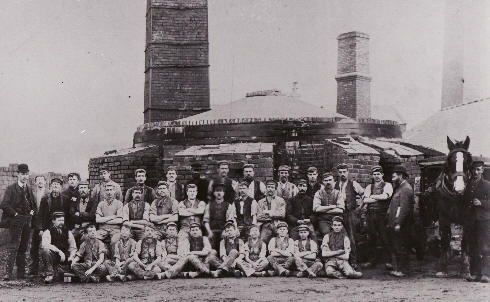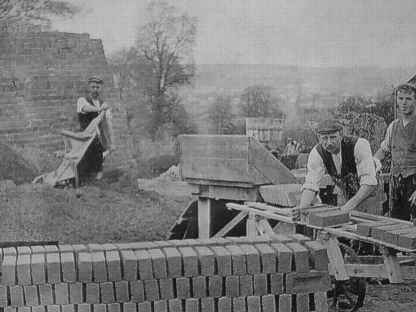Workers
at the Brookhill Works of the Buckley Brick and Tile Company circa 1890.
 They
are posed before one of their round kilns, which were the principal type of
kiln throughout the district. This particular one has large buttresses
which probably housed the fire-grates, which had to be stoked day and night
to maintain the kiln temperature at a precise level. This operation was
carried out by men of great experience, as failure to burn the bricks
properly could result in the loss of the entire contents.
They
are posed before one of their round kilns, which were the principal type of
kiln throughout the district. This particular one has large buttresses
which probably housed the fire-grates, which had to be stoked day and night
to maintain the kiln temperature at a precise level. This operation was
carried out by men of great experience, as failure to burn the bricks
properly could result in the loss of the entire contents.
Another popular type of kiln used was the Continuous Kiln, commonly called the Hoffman Kiln, after its inventor. This was a much larger elongated kiln containing numerous separate chambers. Each of these could be filled, burnt and emptied in rotation, allowing for a great saving in fuel used, as heat within the kiln was never allowed to completely dissipate as happened in round kilns.

This early photo shows brick making at a country works on the Isle of Wight, although such practices were generic throughout the industry. The object in the upper left is a “clamp kiln”; a kiln of new bricks being constructed prior to burning. This type of kiln was a “one off”, which would be totally taken down after the bricks had burnt hard. Kilns like this could be as big as a house, but because of their lower internal temperatures they were not suited to the manufacture of the harder bricks made in permanent kilns at the larger factories.
During Victorian times basis building bricks were often made by Contract Brick makers journeying from building site to building site, utilising clamp kilns such as these. This is an aspect of our landscape which had probably totally disappeared by the start of the 1914 war and one we shall never see again.

